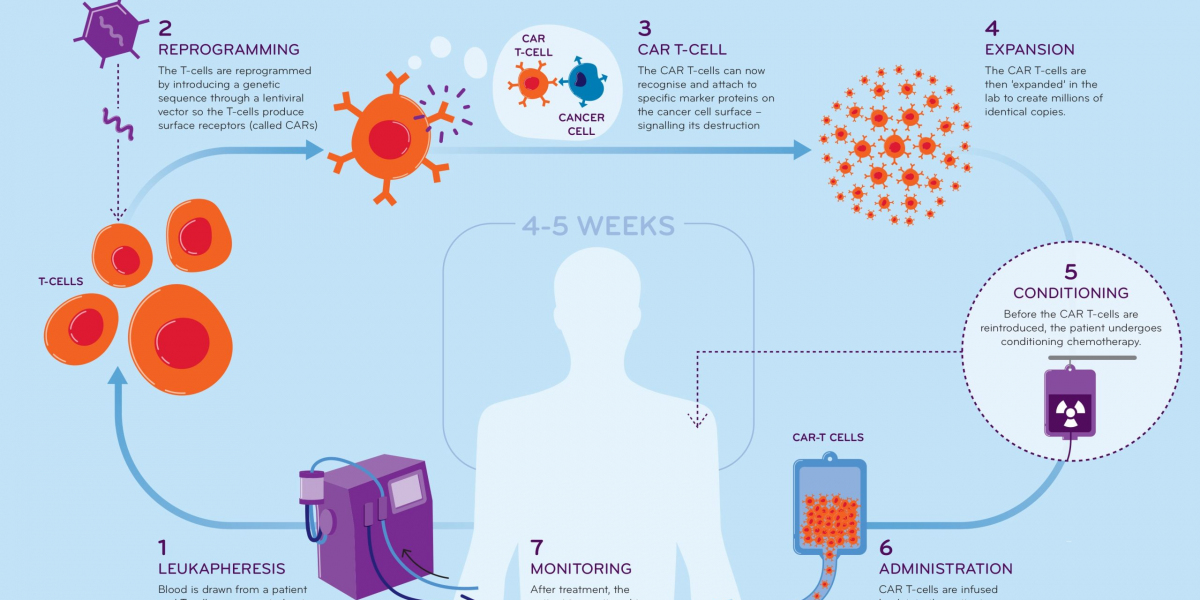In the fight against cancer, researchers have made significant strides in developing treatments that harness the power of the immune system. One of the most promising advancements is CAR T-cell therapy, a cutting-edge form of immunotherapy that has shown remarkable success, especially in treating certain types of blood cancers like leukemia and lymphoma.
What is CAR T-Cell Therapy?
CAR T-cell therapy stands for Chimeric Antigen Receptor T-cell therapy. It is a revolutionary treatment that involves modifying a patient's own T-cells (a type of white blood cell) to better recognize and attack cancer cells. Unlike traditional treatments like chemotherapy or radiation, which target both healthy and cancerous cells, CAR T-cell therapy is a highly targeted approach designed to specifically seek out and destroy cancer cells.
How Does CAR T-Cell Therapy Work?
The process of CAR T-cell therapy is complex but fascinating. Here’s a step-by-step breakdown of how it works:
1. Collection of T-cells
The first step is to collect the patient’s T-cells from their blood. This is done through a process called leukapheresis, where blood is drawn from the patient and T-cells are separated from the other components, such as red blood cells and plasma.
2. Genetic Modification of T-cells
Once the T-cells are collected, they are sent to a laboratory, where they are genetically engineered to express a special receptor called a chimeric antigen receptor (CAR). This receptor is designed to specifically target and bind to a protein (antigen) found on the surface of cancer cells.
The CAR is a synthetic protein made up of parts of antibodies and T-cell receptors. This allows the T-cells to recognize and latch onto cancer cells much more effectively. Essentially, it transforms the T-cells into “supercharged” cells that are capable of seeking out and destroying cancerous cells with greater precision.
3. Expansion of Modified T-cells
After being modified, the CAR T-cells are grown and multiplied in the lab to produce millions of these engineered cells. This ensures that there are enough modified T-cells to combat the cancer effectively.
4. Infusion of CAR T-cells Back Into the Patient
Once there are enough CAR T-cells, they are infused back into the patient’s bloodstream through an intravenous (IV) drip. Now, these modified T-cells are ready to go to work.
5. Targeting and Destroying Cancer Cells
The CAR T-cells travel through the body and specifically seek out cancer cells that have the targeted antigen on their surface. Once they find a cancer cell, the CAR T-cells latch onto it, become activated, and trigger a powerful immune response to destroy the cancer cell. This process helps reduce or even eliminate cancer, especially in blood cancers like leukemia or lymphoma.
Potential Side Effects of CAR T-Cell Therapy
While CAR T-cell therapy has proven to be a game-changer for many patients, it’s not without risks. The therapy can trigger severe side effects, including:
- Cytokine Release Syndrome (CRS): This is a potentially dangerous inflammatory response triggered by the rapid activation of T-cells. It can lead to symptoms like fever, low blood pressure, and organ dysfunction.
- Neurological Effects: Some patients experience confusion, seizures, or other neurological issues as a result of the treatment.
These side effects are closely monitored in the hospital, and doctors are prepared to manage them with supportive care or medications. Despite the risks, the benefits of CAR T-cell therapy can outweigh the potential complications, especially for patients with no other treatment options.
Who Can Benefit From CAR T-Cell Therapy?
Currently, CAR T-cell therapy is primarily used to treat blood cancers, including:
- Leukemias (e.g., Acute Lymphoblastic Leukemia or ALL)
- Lymphomas (e.g., Diffuse Large B-cell Lymphoma or DLBCL)
- Multiple Myeloma (for certain cases)
Research is ongoing to explore its effectiveness in treating other cancers, such as solid tumors, but for now, its greatest success has been in hematologic (blood) cancers.
Conclusion
CAR T-cell therapy represents a new frontier in cancer treatment, offering a personalized and targeted approach to attacking cancer cells. By using the body's own immune system, it provides an innovative way to treat cancers that may not respond to traditional therapies. While still evolving, CAR T-cell therapy has already transformed the lives of many cancer patients, giving them new hope in their battle against cancer.
Research URL :- https://bondhusova.com/blogs/175323/What-is-CAR-T-Cell-Therapy-and-How-Does-It








